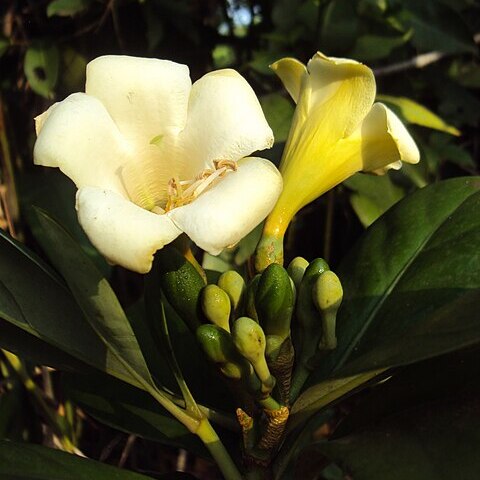Epiphytic or (more rarely) terrestrial shrub, climber, or small tree, up to 15 m. Leaves very variable as to shape and size, varying from ovate to obovate (to spathulate in the Deccan and Ceylon) via oblong or oblong-obovate to narrowly lanceolate, 4.5-35 by 1.5-9 cm, fleshy or coriaceous, base attenuate and decurrent, cuneate, or rounded to subcordate, apex rounded to acute, usually (and mostly gradually) acuminate, acumen short to long and blunt to acute; nerves 4-8(-12) pairs, inconspicuous or mostly invisible (only in the typical form from Ceylon and S. Deccan slightly prominent beneath); petiole slender to robust, 0.5-3.5(-5) cm, exauriculate, the axillary scale appressed to the twig or (more rarely) partly or entirely adnate to the petiole, mostly inconspicuous, rarely somewhat broader than the petiole, 0.25-0.75(-1) cm long, usually rounded, rarely truncate or emarginate, often slightly confluent between the leaves. Inflorescences dichasial, branched from the base, usually rather dense, sometimes laxly thyrsoid and up to 15 cm long, (1-)3-17-flowered; pedicels slender (then usually thickened towards the calyx) to stout, 0.25-3.5 cm long; bracteoles 2, inserted from about halfway the pedicel to just below the calyx, very small to c. 2.5 cm long (usually the more apical the larger), sometimes confluent at the base and together enclasping the calyx. Calyx campanulate to slightly urceolate, 1-2.75(-4) cm long (in Assam 6-7.5 mm), connate for 1/4 to more than 1/2. Corolla widely to slenderly funnel-shaped, tube 2-5 cm (in the typical form from Ceylon and SW. Deccan 8½-10 cm). Anthers oblong to ovate, (3½-)5-7.5(-12.5) mm long, cells free at the base for 1/3-1/2. Stigma obconicaL slightly cup-shaped to peltate, 1-5 mm ø. Fruits ovoid or ellipsoid to subglobular, 3-5 cm long (specimens from Assam 1¾ cm), slightly to strongly beaked, glaucous-white (sometimes mentioned as being coffee-brown or black); calyx often warty-lenticellate, lobes appressed, spreading, or reflexed.
More
Shrubs, scandent epiphytes, or trees to 15 m tall. Branchlets stout, with prominent leaf scars. Stipules scalelike, ca. 1 X 4 mm. Petiole 1--5 cm; leaf blade elliptic, ovate, obovate, or narrowly obovate, 5--25 X 2--10 cm, fleshy to leathery, glabrous, margin entire, lateral veins 4--10 inconspicuous pairs. Flowers terminal, solitary or in dichasial cymes. Calyx broadly campanulate; lobes ovate to rounded, ca. 1 cm. Corolla white, funnelform, tube 3--3.5 cm; lobes obovate, 2.5--3 X ca. 2 cm. Stamens included; anthers oblong to narrowly ovate, 5--7 mm. Ovary ellipsoid to ovoid, glabrous, 2-locular. Style filiform; stigma obconical, slightly cup-shaped to peltate. Berries ovoid, ellipsoid, or subglobose, 3--5 X 2--4 cm, apex slightly to strongly beaked. Fl. Apr-Aug.
A shrub or tree. It can grow 15 m tall. The branches are stout with prominent leaf scars. The leaves are narrowly oval and 5-25 cm long by 2-10 cm wide. The flowers are usually single at the ends of branches. The fruit are oval berries 3-5 cm long by 2-4 cm wide.
Occupying a wide range of habitats, in open localities and along forest edges but also in primary and secondary forests, both on dry and on marshy or periodically inundated soils, under everwet as well as under seasonal conditions, from sea-level up to 2500 m. Fl. mainly in the dry season, fr. in the rainy period.
More
Dense forests, woodlands on limestone; at elevations from 500-1,800 metres in southern china.

